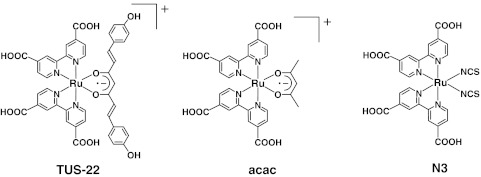Abstract
The first example of a ruthenium sensitizer (TUS-22) having a natural dye, bisdemethoxycurcumin, as a ligand has been synthesized. The dye-sensitized solar cell based on this novel dye showed 5.8% conversion efficiency under AM 1.5 (100 mW/cm2) irradiation.
Keywords: Dye-sensitized solar cells, TiO2 photoelectrode, Ruthenium, Curcumin, Electrochemical impedance spectroscopy
Introduction
Since the pioneering research was reported by O’Regan and Grätzel (1991), extensive studies on the development of efficient sensitizers have been carried out to improve the light-to-electrical energy conversion efficiency of dye-sensitized solar cells (DSCs) in the last two decades (Hagfeldt et al. 2010). We previously reported that β-diketonate ligands are useful for the redox-potential engineering of the ruthenium sensitizer. These dyes1 exhibit high conversion efficiency (Sugihara et al. 2004; Yamaguchi et al. 2007). In this study, a novel ruthenium complex (TUS-22, Fig. 1) based on a bisdemethoxycurcumin (bdmc) has been designed and synthesized. This natural dye (bdmc) has a strong absorption around 410 nm and contains a β-diketone unit that can coordinate to the metal ion.
Fig. 1.
Structures of TUS-22, acac, and N3
The new ruthenium sensitizer (TUS-22) showed strong absorption around 410 nm mainly attributed to the π–π* transition of the bdmc unit. In addition, the molar absorptivity at the MLCT band region for TUS-22 was larger than that for acac. Since bdmc has no absorption at this region, this enhancement is attributed to charge transfer from metal ion to ligand (the formation of the hybridized orbital between the bdmc orbital and the Ru-based orbital). Formation of such a hybridized orbital spread over the Ru-bdmc framework was supported by the DFT calculations. On the other hand, the energy level of HOMO for TUS-22 after adsorbed on TiO2 (0.82 V vs. SCE), determined by the electrochemical measurements, was the same as those for acac and N3. The lowest transition energy (E0–0) for TUS-22 (1.64 V), estimated from the onset of the absorption spectrum, was very close to those for acac and N3, therefore, the energy level of LUMO for TUS-22 (−0.82 V vs. SCE) was also the same as those for acac and N3.
The DSC based on TUS-22 showed 5.8% conversion efficiency (active area: 0.25 cm2) under AM 1.5 (100 mW/cm2) irradiation (Ozawa et al. 2011), where DSCs with acac or N3 showed 6.8 and 7.9% conversion efficiency, respectively. The characteristic absorption of TUS-22 around 410 nm was not reflected in the incident photon-to-current conversion efficiency (IPCE) spectrum, in which about 55% IPCE values were obtained in the wavelength region between 450 and 600 nm. This lower IPCE value for the DSC with TUS-22 was attributed to the lager resistance for the forward electron transfer processes at the TiO2/dye/elecrolyte interface, observed by electrochemical impedance spectroscopy (EIS) analysis. This observation means that the backward electron transfer processes from the conduction band of TiO2 were enhanced. The enhancement of the backward electron transfer processes induces decrease of the electron lifetime in the TiO2 photoelectrode. Actually, stepped light-induced transient measurements of photocurrent and photovoltages (SLIM-PCV method) revealed that the electron lifetime in the TiO2 photoelectrode of the DSC based on TUS-22 was much shorter than those for acac and N3, whereas the energy level for the conduction band of TiO2 sensitized with TUS-22 was almost the same as those for acac and N3. This much shorter electron lifetime is also considered as a major reason for the inferior performance of the DSC with TUS-22. It is noted here that EIS analysis reveals the magnitude of resistance for internal electron transfer processes of DSC at the TiO2/dye/electrolyte interface, counter electrode/electrolyte interface, and the diffusion resistance of the electrolyte. On the other hand, SLIM-PCV method provides various information of the electron behavior at the TiO2/dye/electrolyte interface such as electron lifetime in the TiO2 photoelectrode and electron density in the conduction band of TiO2. These measurements are well known as powerful tools to obtain detailed insights into the photovoltaic performances of DSCs.
In summary, the first example of a ruthenium sensitizer (TUS-22) having a natural dye as a ligand has been synthesized. The DSC with this novel dye exhibited 5.8% conversion efficiency under AM 1.5 irradiation.
Acknowledgments
This study was supported by the New Energy and Industrial Technology Development Organization (NEDO) of Japan. H. O. acknowledges a Grant-in-Aid for young scientist (B) (No. 22750057) from the Ministry of Education, Culture, Sports, Science, and Technology of Japan, and a research grant from Kurita Water and Environment Foundation (No. 23092).
Biographies
Hironobu Ozawa
is an Assistant professor at Tokyo University of Science (TUS).
Hiroki Kawaguchi
is Master course student at Tokyo University of Science (TUS).
Yu Okuyama
is Master course student at Tokyo University of Science (TUS).
Hironori Arakawa
is a full Professor at Tokyo University of Science. His research interests include solar light energy conversion technologies such as dye-sensitized solar cells and solar hydrogen production from water by oxide semiconductor photoelectrode catalysts.
Footnotes
For instance [Ru(dcbpy)2(acac)]Cl (acac, dcbpy = 4,4′-dicarboxy-2,2′-bipyridine, acac = acetylacetonate).
References
- Hagfeldt A, Boschloo G, Sun L, Kloo L, Pettersson H. Dye-sensitized solar cells. Chemical Review. 2010;110:6595–6663. doi: 10.1021/cr900356p. [DOI] [PubMed] [Google Scholar]
- Ozawa H, Kawaguchi H, Okuyama Y, Arakawa H. Synthesis and characterization of a novel ruthenium complex bearing a curcumin derivative ligand and its application to dye-sensitized solar cells. Chemistry Letters. 2011;40:658–660. doi: 10.1246/cl.2011.658. [DOI] [Google Scholar]
- O’Regan B, Grätzel M. A low-cost, high-efficiency solar cell based on dye-sensitized colloidal TiO2 films. Nature. 1991;353:737–740. doi: 10.1038/353737a0. [DOI] [Google Scholar]
- Sugihara H, Sano S, Yamaguchi T, Yanagida M, Sato T, Abe Y, Nagao Y, Arakawa H. Highly efficient photosensitizer of TiO2 with diimine(diketonato)ruthenium complexes. Journal of Photochemistry and Photobiology A: Chemistry. 2004;166:81–90. doi: 10.1016/j.jphotochem.2004.04.036. [DOI] [Google Scholar]
- Yamaguchi, T., N. Shibayama, M. Nakade, Y. Abe, and H. Arakawa. 2007. Development of new efficient Ru dyes having β-diketonate and terpyridine ligands for solar cells. Proceedings of the International Society for Optics and Photonics 6656: 665609-1-12.



